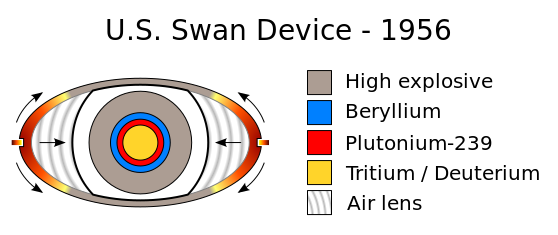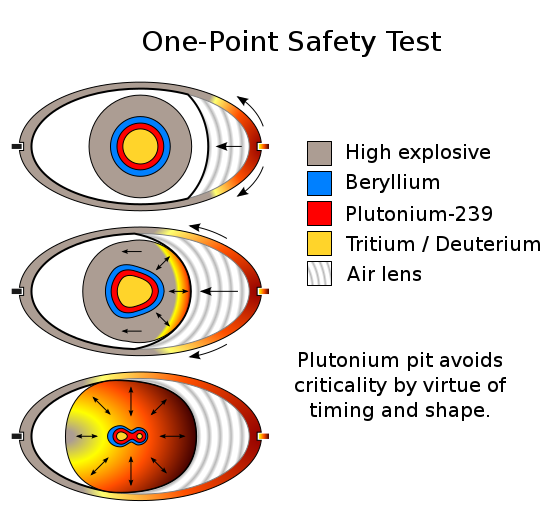Swan (nuclear primary)
This article needs additional citations for verification. (August 2011) |
Swan was a U.S. test nuclear explosive, which was developed into the XW-45 warhead.[1]
It was tested standalone on June 22, 1956 in shot Redwing Inca.[1] It was tested again as the primary of a thermonuclear device on July 2, 1956 in shot Redwing Mohawk.[2] Both tests were successful. It subsequently served as the primary in numerous thermonuclear devices during the 1950s.
Most subsequent U.S. primaries are Swan-derived, including the Robin, the Tsetse, the Python, and the much later (asymmetrical) ovoid (prolate) primaries.
Design features
The Swan device is the first design to incorporate a two-point hollow-pit air lens implosion assembly together with fusion boosting.
The Swan device had a yield of 15 kilotons,[1] weighed 105 lb (47.6 kg),[2] and had a (symmetrical) ovoid (non-prolate) shape with a diameter of 11.6 inches (29.5 cm) and a length of 22.8 inches (58 cm),[2] a length to diameter ratio of 1.97.[3]

The above schematic illustrates what were probably its essential features.
One-point safety
A significant feature of these "two-point" implosion designs is "one-point safety". That is, accidental or intentional ignition of one of the two ignition "points" results in no nuclear yield as the "pit" is compressed into two separate parts, neither of which approaches criticality.

The above schematics illustrate the essential features of this capability.
Production considerations
The super-precision turning machines (lathes) which constructed the components of Swan and Swan-derived primaries could accommodate workpieces which did not exceed 15.5 dia. × 54 inches (39.5 dia. × 137.2 cm);[4] Swan and Swan-derived components were no larger than 12 dia. × 24 inches (30.5 dia. × 61.0 cm).
References
- ^ a b c http://nuclearweaponarchive.org/Usa/Tests/Redwing.html "Inca .. Yield: 15.2 kt. UCRL test of a multi-application boosted tactical nuclear warhead prototype named Swan. This design was later developed into the XW-45 warhead. The predicted yield was 10-15 kt."
- ^ a b c http://nuclearweaponarchive.org/Usa/Tests/Redwing.html "Mohawk. Yield: 360 kt This UCRL thermonuclear device used a boosted "Swan" primary and "Flute" secondary. The device was 15 inches in diameter, 46.2 inches long, and weighed 1116 lb. The primary was 11.6 inches by 22.8 inches and weighed 105 lb."
- ^ L-D ratios of roughly 2.0 had a 100 percent success rate; greater than 2.0 provided no significant benefit, whereas significantly less than 2.0 had a significantly lower success rate; therefore this device class (two-point ignition, air-lens implosion, fusion-boosted) almost always employed an L-D ratio of about 2.0.
- ^ This machine's operational envelope could accommodate device components with an L-D ratio of well over 4.5, but as stated earlier, 100 percent success was achieved at 2.0, and greater than 2.0 had no significant benefit.
